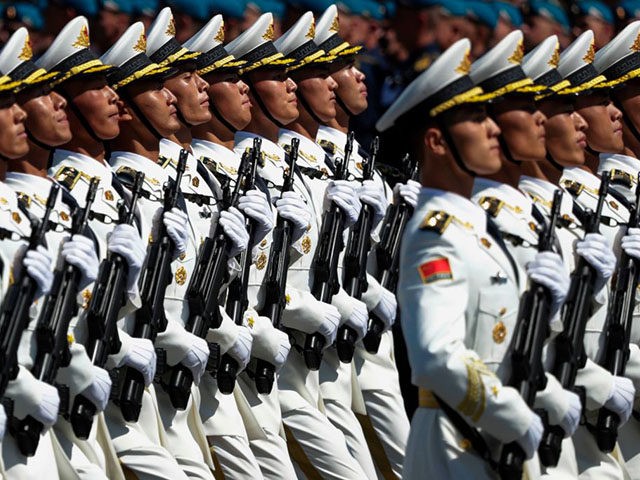China’s Foreign Ministry dismissed reports on Tuesday that as many as 40 People’s Liberation Army (PLA) soldiers died in a hand-to-hand brawl with Indian troops on their mutual border last week, insisting it was “false information.”
While Beijing has denied reports of casualties, it has also refused to provide reporters with any official casualty count following the incident in India’s Galwan Valley, which China has claimed as its own since the brawl occurred. It has also not claimed that no casualties occurred at all, leaving the true scope of the damage to the PLA unclear.
Both India and China claim the fight began when their soldiers caught members of the other country’s military illegally present in their sovereign territory. Indian officials have stated that the Chinese erected a tent in the Galwan Valley in India’s Ladakh region and, when confronted by Indian troops, attacked with rocks, sticks, and barbed wire clubs. New Delhi and Beijing for years had an agreement banning the use of firearms against each other on their border, thus prompting the use of less sophisticated weapons.
The Indian government confirmed the deaths of 20 Indian soldiers shortly after the incident occurred on June 15, adding that some were not beaten to death but instead flung off the steep Himalayan terrain of Ladakh. At least one Indian official speculated publicly that twice the number of Chinese soldiers had died.
Asked for clarity on China’s casualty count, Foreign Ministry spokesman Zhao Lijian responded, “China and India are resolving the issue on the ground through military and diplomatic channels.”
“As for Indian media reports that cite Indian officials as saying at least 40 Chinese soldiers were killed, I can tell you responsibly that this is false information,” he added.
Zhao, newly added to China’s Foreign Ministry spokesperson roster, is best known as the source of the unsubstantiated conspiracy theory that the U.S. Army caused the Chinese coronavirus pandemic.
On Wednesday, Zhao began his regular press conference with an extended statement on the China-India clash that concluded, “none of the responsibility lies with China. Zhao emphasized Beijing’s claim that “the Galwan Valley lies on the Chinese side of the LAC [Line of Actual Control, the formal name for the China-India border].”
Zhao claimed that diplomatic talks are currently underway between the two countries and meeting with some success.
Outside of the Foreign Ministry, China’s Ministry of National Defense also asserted on Wednesday that India was solely to blame for the deadly battle.
“On the evening of June 15, India’s front-line troops, in violation of the agreement reached at the Corps Commander-level meeting, once again crossed the LAC for deliberate provocation, and even violently attacked the Chinese officers and soldiers who went there for negotiation, thus triggering fierce physical conflicts and causing casualties,” Wu Qian, a spokesperson for the Defense Ministry, reportedly said. “In response to such a deliberate provocation, Chinese border troops took decisive countermeasures in self-defense, resolutely fought back against the violent acts of the Indian side, and effectively safeguarded China’s national sovereignty and territorial integrity.”
Wu stated, echoing Zhao, that “China has sovereignty over the Galwan Valley region,” a claim with which India disagrees. Wu added that the battle on June 15 followed months of disgruntlement on the Chinese side over Indian forces attempting to construct road infrastructure in the region. China has been attempting to monopolize global infrastructure through its “Belt and Road Initiative” for several years, including attempts to build connective travel infrastructure in the Himalayas.
“The Chinese side demands that India should severely punish those who should be held accountable, strictly discipline its front-line troops so as to ensure that such incidents do not happen again,” Wu demanded.
While official Chinese channels continued to deny any significant casualties and offered no concrete details on the matter, Indian media reported Wednesday that, behind closed doors, Chinese officials admitted to casualties and insisted that publicizing them would create too much public fervor for revenge in China.
“Exact casualties were not publicised as China did not want the media to play it up. Now was the time for both sides to find ways to de-escalate the situation and restore stability,” He Xiangqi, deputy director general of boundary and ocean affairs, reportedly told diplomats on Wednesday, according to India’s Hindustan Times. The newspaper cited “diplomatic sources” for the information.
The Hindustan Times added that He reportedly told officials revealing Chinese casualties would “trigger antagonism on both sides.”
“This is the first time that a Chinese government official has acknowledged that the PLA suffered casualties and explained the reasons for not revealing the number of the injured or dead,” the newspaper added.
While this was the first time the Hindustan Times reported that Chinese government officials had acknowledged casualties, another Indian media outlet, NDTV, reported Monday that Chinese military officials had confided to Indian counterparts that a PLA commanding officer had died in the battle. Indian government officials had already publicly confirmed the death of one of their commanding officers, Col. B.L. Santosh Babu, in the incident.
Last week, initial reports in the Times of India estimated that the total casualty count of the brawl could go well into the 50s, including the slightly over 20 Indian soldiers killed. News 18, another Indian news network, claimed as many as 110 Indian soldiers needed medical attention in the aftermath.

COMMENTS
Please let us know if you're having issues with commenting.